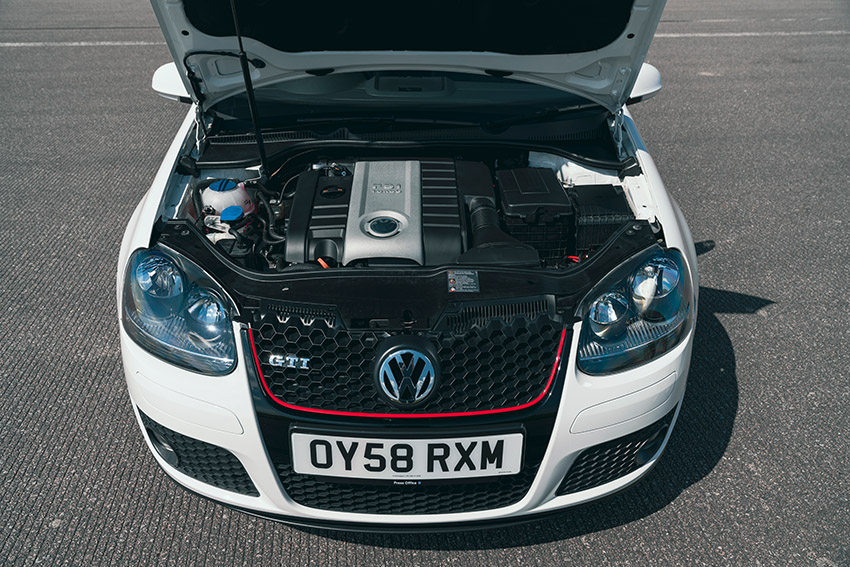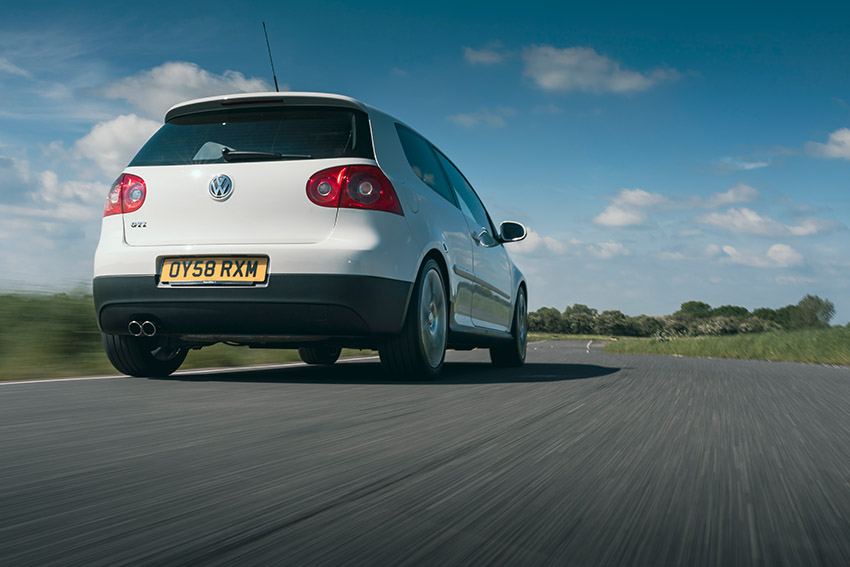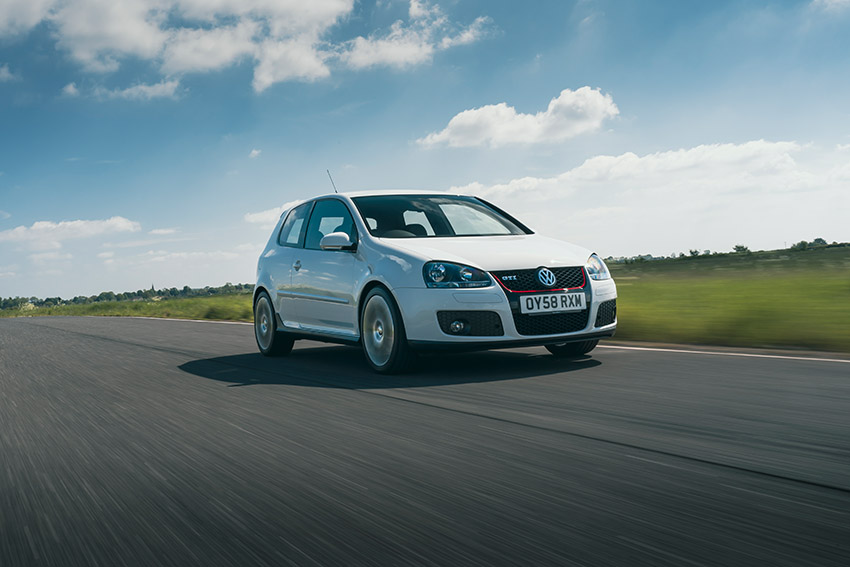Almost five decades ago the Golf GTI landed and took the world by storm. We take a look at what you need to know when buying what we think is a used car sweet spot, the VW Golf GTI Mk5.
The Volkswagen Golf is such an everyday sight today that it’s hard to imagine a society without it. But 1974 was a very different place to the world of today, and the launch of the Golf was a staggering departure from what people thought they knew about the Volkswagen brand; replacing the air-cooled, rear-engined, rear-wheel-drive Beetle with a crisply angular hatchback that featured a front-mounted, water-cooled engine and front-wheel-drive was a frankly astounding manoeuvre. And when the GTI concept was announced at the 1975 Frankfurt Motor Show, all bets were off. This was a new era of performance city cars.
Brilliantly, the secret ‘Sport Golf’ started as a skunkworks project among the engineers; presenting it to top brass in 1975, the idea was met with widespread approval and the Golf GTI came to market for 1976. Fatter wheels, bigger brakes, aero add-ons, a close-ratio gearbox and a peppery engine made it an instant classic. In the early ’80s, the engine got bigger and the power increased, and the legend was assured. Golf GTIs are still massive sellers today, and that little pocket rocket was the magnificent genesis.

VW Golf GTI Mk5 history
It’s fair to say that the trajectory of the GTI has been somewhat bumpy, however. The Mk3 certainly has its detractors, as does the Mk4. However, the VW Golf GTI Mk5 of 2005 was a return to form after a period in the doldrums, and we can view it as the progenitor of the third wave of Golf GTIs that endures to this day. The Mk1 and Mk2 are bracketed together as bona fide classics, the Mk3 and Mk4 are perhaps an acquired taste, and everything from the Mk5 to the current Mk8 is the wave of the future (or, at least, present).
With a turbocharged 2.0-liter engine serving up 200hp, the Mk5’s performance was right where it needed to be, and this impressive motor came with either a slick six-speed manual or a whip-crack DSG twin-clutch auto. A 0-62mph time of around seven seconds assured its straight-line credentials, and it was a proper drive in the twisties too; extensive chassis development resulted in a MacPherson strut front and multi-link rear. The interior is something special as well, with the Interlagos tartan seat trim and dimpled golf-ball gear knob harking nostalgically back to the iconic Mk1.
Unsurprisingly, the VW Golf GTI Mk5 sold like hotcakes, and the used market is positively brimming with them today. There are two formats available: the three-door is for the purists, while the five-door was an ingenious move to package all of these everyday thrills up as a practical family car. And there are also some limited-run specials to be aware of.
Special Editions
The 30th Anniversary Edition (generally referred to as ‘Edition 30’) arrived in 2007 – the fastest production Golf GTI to date, its engine produced up to 230hp, knocking about half-a-second off the 0-62mph time. The Edition 30 is distinguishable by its unique chin spoiler, body-color side skirts and rear bumper, 18” Pescara wheels and redesigned seats. The GTI Pirelli was another special, launched in 2008, paying homage to the original GTI Pirelli of 1983. This new version sported bespoke Pirelli-branded 18” wheels (and Pirelli P Zero tires, of course) along with the Edition 30-spec engine. The whole body kit was painted body color, and the seats featured microfiber trim inserts with a tire tread pattern.

VW Golf GTI Mk5 most common problems
History is crucial when you’re looking at a GTI. These high-performance machines have now passed into the price point where they can be picked up relatively cheaply by the sort of people who aren’t all that bothered about proper maintenance – so for peace of mind, you’ll want to find a car with a nice thick file of paperwork and a fully stamped service book.
Most important to check is that it’s had its timing belt changed at the proper time: there’s a bit of muddy thinking here, as the service-book interval is stated as every 120,000 miles, while dealers recommend doing it every four years or 60-80,000 miles. I’d recommend erring on the side of caution (because after all, timing belt failure could destroy the engine). If it hasn’t been done recently, put it at the top of the to-do list. It’s a relatively pricey job – as it involves removing the downpipe to get access, and you might as well fit a new water pump and thermostat at the same time – but much cheaper than a new engine.
Mk5 Golf GTI Engine issues
The engine itself is extremely robust, but you may notice one or two noises: the rubber diaphragm on the diverter valve can split, and you’ll hear a boost leak (this will most likely trigger a warning light on the dash too), while a rattle on start-up that disappears and reappears will most likely be a failing fuel pump. Coil packs are known to fail, but this is easily remedied; a misfire will be the tell-tale.
Transmission
If a manual-equipped Golf has a heavy clutch, it’ll be due for replacement – in normal operation it should be nice and light. With DSG cars, make sure that the transmission has been serviced correctly, as a neglected unit will be jerky and sluggish.
Chassis
As far as the chassis is concerned, check for uneven tyre wear. It’s usually caused simply by poor alignment so it’s nothing to worry about, but it’s a good bargaining chip.
It’s not uncommon for suspension springs to break, so that is something you should factor in when buying one. The plus side is that replacement springs aren’t expensive and there are plenty of aftermarket options available if you want to sharpen things up.
Interior
The interior was well put together in its day, but now some examples can be a little tired. Ensure everything works in the cabin, there are no tears in the seats and that there are signs the owner has cleaned the interior at least once…
Final check points
Use common sense. Make sure its been serviced correctly, replacement parts are of a good quality and were fitted correctly. Be on the look out for panel gaps or mismatched paint from repaired accident damage.

VW Golf GTI Mk5 modifications
The Mk5 GTI has been roundly embraced by the modifying community for many years now, and there’s a massive aftermarket to support it. Whether you want to turn your GTI into a fast-road weapon, a track car, or an out-and-out show build, you have a near-overwhelming range of options to choose from.
A good starting point is to address the suspension. Uprated lowering springs are an easy option for improved aesthetics and dynamics, although going one step further will pay dividends: a set of BR-Series coilovers from BC Racing for example. Throw in some Whiteline anti-roll bars and get a proper four-wheel alignment, and the chassis will be transformed.
The world’s your oyster when it comes to wheels; with a PCD of 5×112 and ET35-45 there’s oodles of choice on the aftermarket, and of course, the VAG is extensive so there are countless OEM+ options. There’s a lot of choice with brakes too – a simple rotor/pad upgrade from EBC will with some aftermarket pads will upgrade your braking, and and braided lines are a sweet addition to firm up that pedal feel. Or if you’re going all-in, eight-pot upgrades are available from K-Sport.
Engine tuning
Power mods? Now we’re talking… as with any modern VAG product, a simple plug-in remap can unleash huge amounts of extra power and torque; a Stage 1 remap from Revo will take you up to around 230-255hp and 255-285lb ft of torque. A full 3” exhaust system including downpipe is a must – a turbo-back race Milltek system is brilliant with a de cat downpipe– you’ll be needing a Stage 2 map to really feel the benefit of this, and upgrading the induction will be necessary too; the ITG Maxogen system is a great choice. And once you’re throwing bigger power through the front wheels, a limited-slip diff is a good idea; a Quaife ATB would work wonders here.

Our Choice
There was a time when our go-to choice would have been the Edition 30. After all, it’s essentially the ultimate factory spec for a VW Golf GTI Mk5, and owners are so enamored of these cars that they’ve started to enjoy an almost cult-like following among ‘lesser’ GTIs. However, it’s this growing collectability that would perhaps steer us away from an Edition 30 these days – given that the Mk5 platform is so receptive to performance modifications, we’d be wanting to change a few things, and sullying the purity of a collectable seems a bit extra. So we’d be tempted to find a decent, all-original example of an early GTI, ideally a 2005 three-door in Tornado Red with the Monza wheels, and use that as a base for a fun project.
VW Golf GTI Mk5 Verdict
Few cars are as iconic as the Golf GTI, and few have been embraced by the modifying community with such fervor as the Mk5. Indeed, it’s got to the stage that the show scene is so lavishly populated with them (as are the paddocks at any given track day) that it can take a bit of head-scratching to figure out how you can make your Golf stand out from the crowd. Thankfully there’s a massive aftermarket supporting these cars so no two Golfs are exactly the same… and besides, not everyone’s building a one-off for head-turning purposes, so it’s good to know that all the right bits are available off-the-shelf.
It’s almost laughably easy to make these cars eye-wateringly quick with just bolt-on upgrades and plug-in remaps, and the chassis can be fine-tuned to perfection with, again, easily available parts. Or perhaps you just want to keep the VW Golf GTI Mk5 stock and enjoy it for what it is. And that’s totally achievable too; there are plenty of unmodified low-mileage examples out there, and the servicing and maintenance parts are inexpensive and simple to source. Now, as ever, the Golf GTI truly represents accessible performance for everybody.
Love German cars? Be sure to check out German Car Festival.





